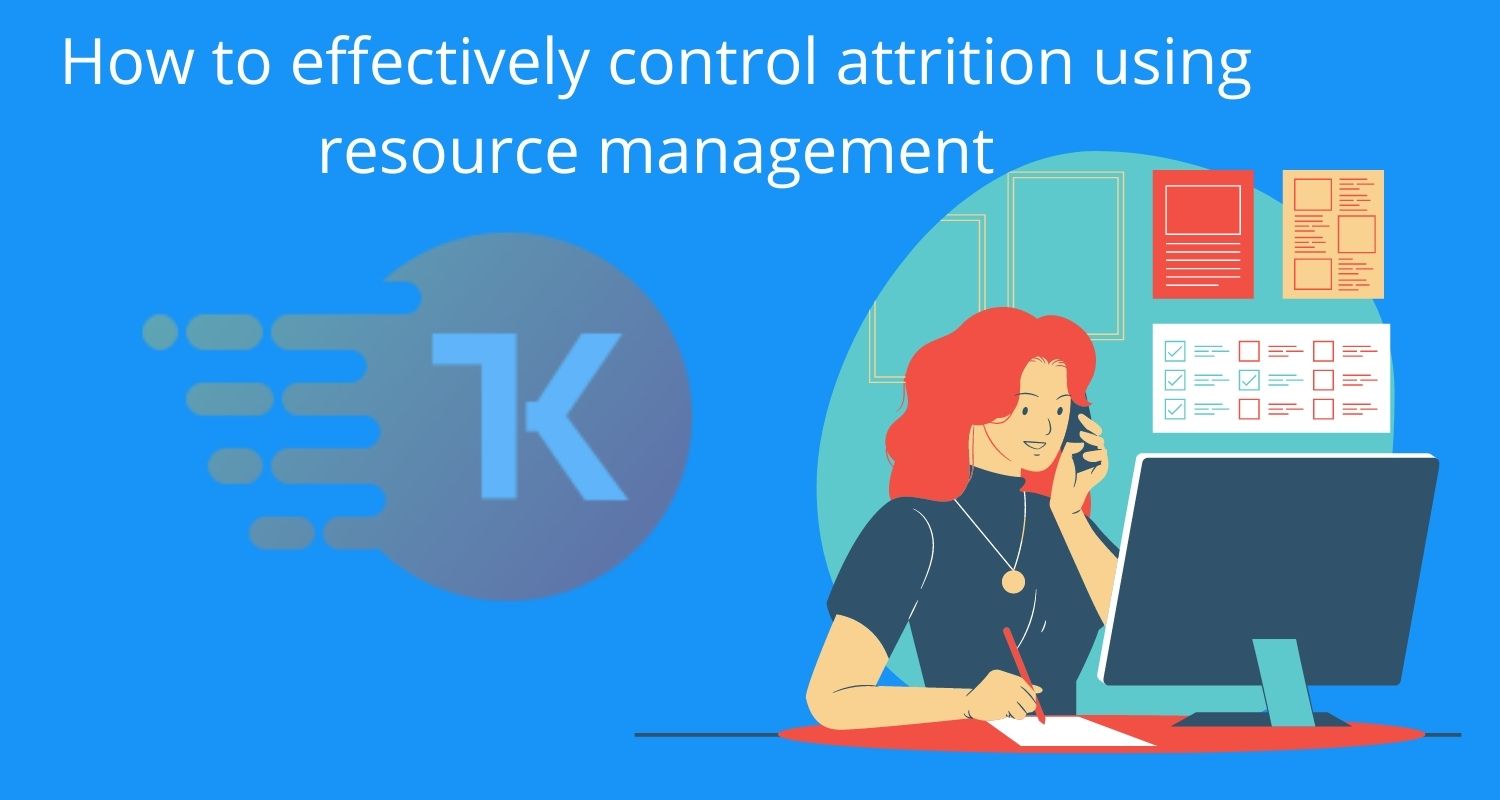How to effectively control attrition using resource management

Employees leaving and joining the organization is the part and parcel of any business. The real challenge occurs when the impact of employee attrition on the organization is negative instead of positive.
Positive attrition happens when the loss or replacement of an employee is for the organization’s betterment. Negative attrition stems from the loss of high performers that adversely affect the organization’s bottom line.
In a recent report by the US Bureau of Labor Statistics, approximately 3 million employees are quitting their jobs every month. Substantial lead time and additional cost of providing compensations to fired employees lead to loss of productivity and revenue. Besides, the delay and expenses incurred during onboarding a replacement dampen productivity and profitability. While there are preventive measures like outplacement support, Attrition also creates a bad reputation for a business.
This article aims to help you understand how Resource Management Solution enables businesses to control attrition. Before delving deep let us get the basics right.
What do you mean by attrition?
Employee attrition refers to the reduction in staff numbers in the form of layoffs or when the employee resigns or retires.
There are typically two kinds of employee attrition-
- Voluntary attrition means when employees leave on their own accord due to personal reasons or better opportunities.
- Involuntary attrition happens when the organization decides to part ways with an employee. Firing or laying off are the two major types of involuntary attritions.
How can resource management control attrition:
A Resource Management solution can help businesses manage their resources most effectively and efficiently. It helps reduce costs and improve productivity and control attrition significantly.
Let us find out exactly how:
1. Avoid constant overloading of resources with work:
Work overload is one of the significant causes of employee burnout. Voluntary attrition is often directly proportional to burnout. A Gallup study revealed that burnout employees are 2.6 times as likely to leave the present company.
Modern resource management solutions provide complete visibility of resources. Real-time information about resource utilization and availability reduces the chances of overbooking them against their capacity. Besides, the system sends overloading alerts to resource managers, so that they can avoid it in the first place.
JAMS offers a batch scheduler with powerful workload automation features.
2. Keeps employee skills and interests in mind:
Another root cause of voluntary attrition is resource allocations on tasks without keeping employee skills and interest in mind. This is when employees start looking for career advancement opportunities elsewhere. Gartner insights show that more than 40% of involuntary attrition stems from career development. Not using employees’ skills to their potential can make them feel stagnant in their careers. Due to which they feel demotivated and start looking for opportunities that look promising for their professional growth.
Resource management solutions extract all resource-related information into a single source of truth. All data, including skills, qualifications, experience, are captured in real-time. Furthermore, resource scheduling and planning helps in allocating tasks as per the employee’s interests and abilities. It also helps improve employee productivity and supports their Individual Development Plans (IDP).
3. Eliminate wrongful hiring of resources:
In the absence of a clear picture of the skill sets required to fulfill future project resource demands, managers end up making blind hiring decisions. Poor hiring choices can result in productivity loss and attrition. Harvard Business Review reveals that 80% of employee turnover stems from bad hiring decisions. A Resource management tool can help businesses fix this problem to a large extent.
Capacity planning aids in forecasting future and pipeline projects along with their resource requirements. It aids in formulating a forward plan for future or pipeline projects’ resource requirements. Forecasting proactively helps in identifying and acquiring cost-efficient competent resources ahead of time. Hire skill sets that will be an asset to the organization and aptly fit the demand for future projects. Therefore, resource management solutions help in making informed hiring and training decisions to have an optimally balanced skill pool.
4. Reduce unnecessary hiring/firing costs:
Frequent hiring or firing can adversely affect a company’s reputation and existing employee’s morale. Market volatility and economic uncertainties can provoke businesses to take extreme steps to cut costs. Abrupt firing and laying off employees are some of them.
These reactive measures are a temporary fix, but impacts business sustainability in the long run. Firing employees increases the Cost per Hire or CPH, which is the total of all costs associated with finding a replacement. Human Capital Benchmarking report points out that the average CPH is $ 4,129 and the average lead time to fill in a vacancy is 42 days.
Moreover, most organizations fire resources only to hire employees having the same skill set, but, at a higher price. Forecasting capacity vs demand is one of the best practices of resource management solutions. It provides adequate time to take corrective actions and avoid last-minute hiring/firing activities. These include smoothening project workload, employee reskilling, and hiring on-demand workforce, which helps in reducing hiring/firing costs significantly.
5. Minimize large bench of mismatch skillset:
Lack of intelligent tools for resource allocations often results in assigning tasks to people who lack the skills to execute them. Due to this organizations can end up having a large bench of mismatched skillset. Benched employees adversely impact the bottom line that ultimately leads to involuntary attrition.
Resource management solutions provide 360-degree visibility of resources along with their competency information in real-time. Accordingly, booking resources with the right skill sets minimizes the risk of having benched resources. It helps reduce project resource costs and increases profitability.
6. Identifies skill shortages ahead of time:
According to LinkedIn’s Workplace Learning Report, 94% of employees are willing to continue if their employer invests in learning. But without a clear picture of which competencies can meet the future work demand, organizations procrastinate training measures. Foresight into the future resource demands provides ample buffer time to have a skilled resource pool. Scientific forecasting methods help the organizations to identify the skill gap and take appropriate measures to bridge this gap.
Demand capacity planning foresees future and pipeline project requirements ahead of time. These insights help train the employees beforehand so that they are skilled to take up future assignments. Reskilling and training also provide career development, engage IDP, and increase productivity.
7. Avoid allocating under-skilled/over skilled resources:
Lack of visibility across the enterprise often leads to assigning under or over skilled resources on projects. If the allocated resource lacks the competency needed to execute the specific job, it causes project delay and may lead to frustration and employee disengagement. Overqualified employees lead to a spike in budget and also leave the employee feeling bored and essentially deprived. In both cases, the chances of attrition rates are high.
Resource scheduling and planning helps in workforce optimization. It helps identify and deploy resources based on their skills, experience, cost rate, and qualification to the right job. It reduces the chances of allocating under and over skilled resources on tasks.
The Takeaway:
Attrition, whether voluntary or involuntary causes a decline in revenue. Quantifiable numbers to hidden costs incurred while recruiting and training a replacement are substantial. Also, the lead time and months spent on the onboarding process adversely affect the bottom line. Besides, loss of productivity can create a bad image, lead to customer churn, and decrease profitability. Concluding from the above points, resource management solutions can significantly reduce attrition, boost revenue, and increase productivity.






